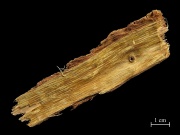Difference between revisions of "Haji"
Jump to navigation
Jump to search
m (Text replace - "== Authority ==" to "== Sources Checked for Data in Record ==") |
|||
| Line 15: | Line 15: | ||
| − | == | + | == Sources Checked for Data in Record == |
* R.Feller, M.Curran, C.Bailie, 'Identification of Traditional Organic Colorants Employed in Japanese Prints and Determination of their Rates of Fading', ''Japanese Woodblock Prints'', Allen Memorial Art Museum, Oberlin College, Oberlin, 1984 | * R.Feller, M.Curran, C.Bailie, 'Identification of Traditional Organic Colorants Employed in Japanese Prints and Determination of their Rates of Fading', ''Japanese Woodblock Prints'', Allen Memorial Art Museum, Oberlin College, Oberlin, 1984 | ||
Revision as of 05:01, 1 May 2016
Description
The Japanese name for a traditional Japanese yellow colorant obtained from the Japanese wax tree, (Rhus succedanea). The major colorant in haji is Fustin. The wax tree is primarily cultivated for the wax from its berries (see Japan wax) and for its sap which forms a natural lacquer (see urushi).
Synonyms and Related Terms
haze (Jap.); Rhus succedanea
Additional Images
Sources Checked for Data in Record
- R.Feller, M.Curran, C.Bailie, 'Identification of Traditional Organic Colorants Employed in Japanese Prints and Determination of their Rates of Fading', Japanese Woodblock Prints, Allen Memorial Art Museum, Oberlin College, Oberlin, 1984
- Encyclopedia Britannica, http://www.britannica.com Comment: "Rhus" Encyclopædia Britannica [Accessed March 5, 2002].

